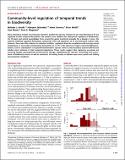Community-level regulation of temporal trends in biodiversity
Abstract
Many theoretical models of community dynamics predict that species richness (S) and total abundance (N) are regulated in their temporal fluctuations. Here we present novel evidence for widespread regulation of biodiversity. For 59 plant and animal assemblages from around the globe monitored annually for a decade or more, the majority exhibited regulated fluctuations compared to the null hypothesis of an unconstrained random walk. However, there was little evidence for statistical artifacts, regulation driven by correlations with average annual temperature, or local-scale compensatory fluctuations in S or N. In the absence of major environmental perturbations such as urbanization or cropland transformation, species richness and abundance may be buffered and exhibit some resilience in their temporal trajectories. These results suggest that regulatory processes are occurring in spite of unprecedented environmental change, highlighting the need for community-level assessment of biodiversity trends, as well as extensions of existing theory to address open source pools and shifting environmental conditions.
Citation
Gotelli , N , Shimadzu , H , Dornelas , M , McGill , B , Moyes , F & Magurran , A E 2017 , ' Community-level regulation of temporal trends in biodiversity ' , Science Advances , vol. 3 , no. 7 , e1700315 . https://doi.org/10.1126/sciadv.1700315
Publication
Science Advances
Status
Peer reviewed
ISSN
2375-2548Type
Journal article
Description
N.J.G. was supported by the NSF (DEB 1257625, DEB 1144055, and DEB 1136644). A.E.M. acknowledges support from ERC AgG BioTIME (250189), ERC PoC BioCHANGE (727440), and the Royal Society. M.D. is grateful for the support from the Scottish Funding Council (Marine Alliance for Science and Technology for Scotland grant reference HR09011).Collections
Items in the St Andrews Research Repository are protected by copyright, with all rights reserved, unless otherwise indicated.

